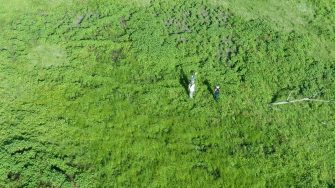
Date: Tuesday, November 13, 2018
Project: Eastern Australian Waterbird Survey
Observer: John Porter
The final day of aerial survey for 2018 dawns clear and cool – we start early, hoping to beat the heat as we head into the Gwydir wetlands again to complete our counting. Our first count is along the main channel of the Gwydir River
Counting along the main channel of the Gwydir River
As we progress over the wetlands we encounter a team of OEH scientists monitoring waterbirds on the ground and give them a friendly wave from above
OEH scientists monitoring waterbirds on the Gwydir (Photo: Terry Korn)
Again we see the benefits of environmental “community” water as we fly across pockets of emerald green in an otherwise extremely dry landscape. There are moderate numbers of Egrets, Grey teal, Black duck, Pacific and White faced herons.
Waterbirds on the Gwydir near Westholme (Photo: Terry Korn)
Stubble bales awaiting collection on the edge of an irrigated field (Photo: Terry Korn)
Counting in the Gwydir wetlands near Westholme
Our counts on the Gwydir now complete, we gain altitude and head for the northern end of the Macquarie Marshes. We arrive at the marshes to find another delivery of environmental “community” water doing a great job of recharging parched wetlands and providing a refuge for aquatic biota in the surrounding dry landscapes.
We methodically work our way back and forth across the marshes but encounter only low numbers of waterbirds. Despite checking as many colonial nesting sites as we can, we can see no signs of breeding activity. This year we have seen very low numbers of birds breeding across the study area in Queensland, NSW, Victoria and South Australia.
Macquarie marshes community water flowing through a parched landscape (Photo: Terry Korn)
Macquarie marshes open water in dense reed beds (Photo: Terry Korn)
Macquarie marshes water spreading across floodplain (Photo: Terry Korn)
Counting over the Maquarie Marshes
Macquarie River at the southern extremity of the marshes (Photo: Terry Korn)
We complete our last transect, and wrap up the 2018 Waterbird and wetlands aerial survey field program. We owe a debt of gratitude to our Pilot (Tim Dugan NSW National Parks & Wildlife) and intrepid aerial observers (Terrry Korn, Stuart Halse & Andrea White) and to our new trainees for the year (Shannon Dundas, Terry Korodaj, Amelia Selles, Jason Higham, Karl Hillyard, Jody O’Connor and Heath Dunstan)
Thanks also to our funding partners in NSW Office of Environment & Heritage, South Australian Department of Environment, Water and Natural Resources, the Queensland Department of Environment and Heritage Protection, the Victorian Department of Environment, Land, Water & Planning , the Victorian Game Management Authority and the Murray Darling Basin Authority
Special thanks to Terry Korn, one of UNSW Aerial Survey’s longest serving waterbird observers, navigators and logistics advisors (Photo: John Porter)
